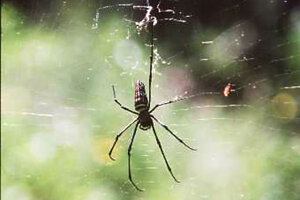Giant spider webs invade Dallas suburb: Where did they come from?
Thousands of spiders coming together to weave 40-ft-tall webs in Rowlett, Tex., are 'more to be appreciated than feared.'

A large spider lies in the center of its spiderweb in a rural setting in the village of Sumberawan in Indonesia.
Melanie Stetson Freeman/Staff
Thousands of spiders joining forces to build webs tall enough to cover trees may sound like something straight out of a horror movie, but that's exactly what's happening in Rowlett, Texas.
Visitors driving along CA Roan Drive, a tree-lined stretch of road in the Dallas suburb, will notice giant “glistening webs ... draping the trees like shrouds," as described by Mike Merchant, a Texas A&M AgriLife Extension Service entomologist in Rowlett. These webs extend up to 40 feet and are inhabited by the thousands of spiders who came together to spin them in a communal effort.
This phenomenon, while rare, is not unprecedented. In 2007, more than 3,300 curious visitors flocked to see a giant spider web in Lake Tawakoni State Park, roughly 35 miles from Rowlett. Park Superintendent Donna Garde described the sight as "something out of a low-budget horror movie, but I was looking at something five times as big as what you'd see on a Hollywood set."
The monster webs on the shores of Lake Tawakoni set the international arachnology community abuzz, and caused many to wonder whether they were witnessing a once-in-a-lifetime phenomenon.
“At the time, the discovery of the web was more than creepy – it was a revelation to many arachnologists,” Mr. Merchant told AgriLife Today. “That’s because spiders typically work alone to construct their webs. So finding spiders working together to build a huge web in what was more of a cooperative or ‘communal’ scenario was a real surprise for many experts.”
The spiders were ultimately identified as Tetragnatha guatemalensis, a species that had been previously known to build communal nests under certain conditions, but rarely in the United States. Mike Quinn, a Texas Parks and Wildlife Department biologist, theorized at the time that the park’s spider population was much larger than usual that summer because of wet conditions that resulted in an abundance of midges and other small insects that make up the spiders' diet.
Tetragnatha guatemalensis, dubbed the Guatemalan long-jawed spider by Mr. Quinn, can be found in areas ranging from Canada to Panama. The spider is approximately an inch long and has a red-orange head and thorax.
While the exact identity of the spiders in Rowlett is yet to be determined, it's likely that they are also long-jawed spiders belonging to the Tetragnathidae family. Fortunately for the residents of Rowlett, these spiders are not known to bite or be harmful to humans. They take a "more the merrier" attitude with other spiders as well, showing no signs of aggression toward other species sharing their web.
“Insecticides or other treatments are really unnecessary as this spider is essentially harmless," Merchant said. "Although the communal nest may look spooky, they too are basically benign and are a sight more to be appreciated than feared."

